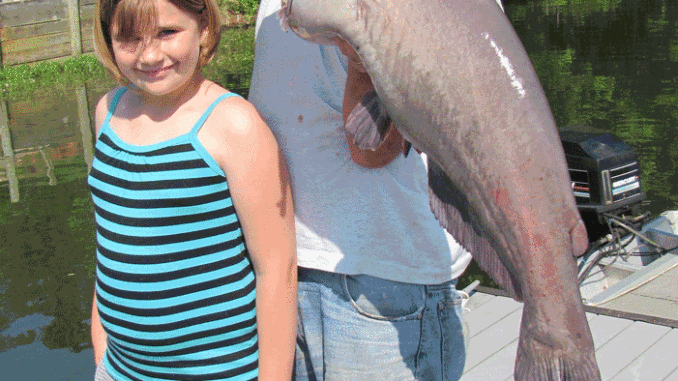
A pronounced thermocline sets up great summer fishing for a variety of species on this popular lake.
Fishing may slow on some lakes because of the intense August heat, but that’s not the case at Lake Wateree. It may be tough on the fisherman to stay through the mid-day heat, but largemouth bass, catfish, striper, crappie and bream are all biting.
Guide Chris Heinning said the lake is very fertile and, because a well-defined thermocline sets up in the lower half of the lake, the oxygen content actually restricts the depths in which you’ll find fish.
“The thermocline usually sets up in the 16-foot depth range, give or take a foot or two, based on weather and water conditions,” Heinning said. “This puts several species of fish at very fishable depths. Another thing fishermen will notice is that this lake is absolutely loaded with forage, something they will see on their graphs as they motor around the lake.
“The keys to success for most fish will be finding the right structures to fish at the depth the thermocline sets up and where forage is found is good supply. The presence of current flow is certainly a positive factor during August.”
Heinning said Wateree is a great August destination because multiple species are often caught from the same targeted hotspot.
“Because the thermocline establishes a depth preference for several species, it is not uncommon to catch largemouth bass, striper, crappie, catfish, white perch and bream all at the same place,” he said. “Different tactics may be necessary for different species, but many of the best spots are excellent for multiple species of fish.”
Roger Taylor guides for catfish on Lake Wateree; he said August can be an excellent month for both quality and quantity, fishing by day or night. Taylor will focus on the upper sector of the lake for big blue catfish, but he said good catfishing will be spread across the entire lake.
Chuck Porter, a veteran Lake Wateree fishermen who targets stripers, catfish and bream, said all can be caught in August.
These experts will share their expertise at specific hotspots from one end of the lake to the other.
1 Rochelle Creek/Martins Branch humps, points
34 24 236N/80 49 594W
Three prime structures combine to provide ideal mid-summer fishing in this area. The junction of Rochelle Creek and Martins Branch creates a natural attraction for several species, and well-defined structure surrounded by deep water create a recipe for sensational fishing.
Heinning said this mid-lake area sets up perfectly for August fishing with a wide variety of largemouth opportunities in a very small area.
“First, the hump is defined by hazard markers, so it’s easy to spot,” he said, “but to fish it properly at this time of the year, it’s best to get there early and work the top of the hump. Square-billed crankbaits work well during mid-morning, but this is also a great place for mid-day fishing. I like a shaky-head-worm rig, along with a Carolina rig for working down the sides and around the base of this rocky hump during mid-day. Also, deep-diving crankbaits will produce.
“Use your graph to work around the entire structure, because the bass can be holding anywhere.”
Heinning said the point at the mouth of Rochelle Creek, easily recognized by the lighthouse, has lots of rocks and underwater cover, making for some excellent early morning fishing with shallow-water lures.
“The junction of these creek channels in association with this hump creates a diversity of productive bass habitat for August,” he said. “The shallow weedbeds at the creek mouths along with the docks that provide shade and cover near deep water are also good places to probe for August largemouth.”
Porter added the base of this hump on the main-channel side is a great spot to hook up with catfish during the summer. The depth of 16 to 18 feet is ideal for the normal thermocline, and blue and channel catfish are taken here in good numbers using cut shad as bait.
2. Colonels Creek Humps
34 22 234N/80 47 066W
Several offshore humps in this area and provide plenty of targets in the prime depth zone for August
Heinning said the humps and ledges where Colonels Creek narrows is an ideal August largemouth spot.
“The Colonels Creek area has several humps and drops fishermen can target in addition to the points that drop into the deep water in this area,” he said. “Most of the humps rise to about 12 to 14 feet deep, with water dropping to 25 feet off the sides. All of these are prime contact areas for schools of hefty largemouth. The depth is ideal for the thermocline that sets up in the lake at this time of the year.
‘The lures I like here are the heavy football jigs, spoons, heavy double willow blade spinnerbaits, such as the ¾-ounce size, as well as Carolina-rigged worms, shaky head worms and deep- diving crankbaits. The crankbaits are a very effective way to search the area looking for bass. Once fish are found you can target the precise area with bottom bumpers.”
Porter said the humps are also prime places for schooling stripers, as well as for trolling deep-diving lures during the middle of the day. Crappie fishermen will troll the ledges with small jigs, and the Colonels Creek bridge is an ideal August crappie and bream hotspot. Some anglers will fish from the bridge at night using lights with excellent results on crappie, white perch and catfish.
3 Horsechestnut Trail Point, Ledge
34 22 300N/80 45 078W
A variety of fish species can be caught at this point and ledge adjacent to the river channel.
Heinning said this deepwater point is productive throughout the day because the river channel runs close to the point and along the adjacent rocky ledge. He said it is also one of the better places to begin at first light with topwater lures such as a buzzbait or a topwater popping lure.
“The topwater bite won’t last long, but the presence of rocks and quick access to deep water is the key,” he said. “Fish the top of the point around the rocks, weeds and docks. Later in the day, work further off the point and down the steep, rocky ledge that falls into deep water. I really like this point when there’s a bit of wind blowing baitfish into it and a shad-imitating crankbait will produce very well. During mid-day, work worm rigs in the deep water. “
Porter said this area is also a known producer of excellent striper action, and schooling fish are caught in the area. Some anglers will fish at night, drifting live shad or shiners about 16-feet deep for stripers. Bream fishing is excellent along the steep rocky banks in this area, fishing crickets or small spinners about 4 to 6 feet deep.
4 Clearwater Landing Hump
34 22 328N/80 44 135W
Multiple species can be caught in this area using jigging spoons, including largemouth, stripers and big white perch.
Heinning said the hump right in front of the Clearwater Landing, a site where many bass tournaments are held, is a frequent target for bass fishermen. The hump is marked by a hazard buoy which makes it easy to spot, but the deeper area around the hump, in the 10- to 16-foot depth range is the key except for very early in the day.
“The top of the humps comes up to very shallow water and right a dawn and dusk, even during the summer, topwater lures will produce here,” Heinning said. “In addition, the hump drops into deep water, and working crankbaits and bottom-bumping lures is very effective throughout the day for quality largemouth.
“This is a very popular spot, and although fished a lot, success is a matter of timing, just be there when the bite turns on. You may fish it a couple times — or see other fishermen working it — but if you’re on it when the bite begins you can catch several quality fish quickly. As a bonus, this is also a prime place to find stripers schooling on and around the shallow hump as they push shad to the shallower water. Jigging spoons around the hump in 16 to 20 feet of water will often produce both largemouth and stripers.”
5 Bird Island
34 24 400N/80 48 201 W
The high spots marked by hazard buoys are productive, but the entire shoreline around Bird Island toward June Creek is excellent.
Heinning said the primary target is the shallow humps near deep water marked by hazard buoys, but the entire area around the Bird Island point, toward June creek, is very good.
“The high spot provides good deep-to-shallow water access, and working these area with Texas rig worms and spinnerbaits is very good,” he said. “Early and late, topwater activity is good. Around the shoreline of Bird Island and just off the shoreline in slightly deeper water are stump fields that provide excellent largemouth holding cover for August fishing. I’ll work this area with both spinnerbaits and worm rigs to cover the territory until I pinpoint the fish.”
Porter said the main river channel turns sharply and close to Bird Island on the June Creek side and creates a great place for drift fishing for summertime catfish. The fish will often be found in that fairly narrow stretch between the Bird Island shoreline and the deep river channel. Look for the catfish to be in the 10- to 16-foot depth range.
6. Mouth of Wateree Creek
34 28 025N/80 53 196W
Multiple structures are found in this complex area. The creek and river junction, an underwater island in the middle of the river and the north point of the creekmouth are prime targets.
Taylor typically fishes the upper end of Lake Wateree during the summer months, and this entire general area is known for holding catfish, especially big blue catfish.
“Catfish have a great diversity of places to hold in this area,” Taylor said. “The entire general area at the intersection of Wateree Creek with the river channel is excellent,” he said. “But right out past the front of Wateree Creek the main-river channel actually flows around both sides of an underwater island. When there’s current, this is a great place to both anchor or drift fish for catfish. The drift fishing here, and along the river channel edge downstream from Wateree Creek, is good throughout the summer. The area is also a good place for anchor fishing for catfish and will produce both day or night.”
Heinning said the upstream point of Wateree Creek, around the area marked by the hazard buoy, is also good for largemouth bass during the summer.
“When a noticeable current is present in this sector of the lake the bass bite is often on,” Heinning said. “This point slopes from 5 to 6 feet deep, then drops into the 10- to 14-foot depth range before dropping into the deep water of the river channel. Crankbaits and worm rigs work well here for largemouth.”
7 Upriver Bluffs, Points, Deep Holes
34 30 009N/80 52 512W
A series of rocky bluffs and points drop into deep holes, offering excellent fishing for multiple species.
Taylor said that when current is flowing in the upper end of Lake Wateree, the catfishing can be good upriver throughout the entire year.
“There are big catfish in the river section year-round, but during the summer, it helps to have some current flow since most of the water is not very deep,” Taylor said. “However, there are deep holes, and along these edges of deep water areas are prime places to hook into big blue catfish. There is one hole that is over 50 feet deep. The only place that rivals that for depth in the entire lake is at the far end in the lower part of the lake near the Wateree Dam. Cut bait such as shad, bream and white perch are ideal baits for big blue catfish in this areas during August.
“Anchor-fishing is best up here because the bottom is ragged, with big rocks and boulders and drifting is difficult. When current is flowing it’s an ideal situation to set multiple catfish rigs baited with cut shad, perch or bream and the big blues will find you.”
Heinning said these same points of rocks that tumble into the deeper holes will hold largemouth and can be fished with mid-depth running crankbaits in a shad pattern as well as jigs. Porter said the bream fishing is excellent all along these bluffs and rock banks using live bait or small Beetle Spins.
8 Island Humps
34 21 325N/80 43 083W
A series of high spots near the main-river channel create ideal fishing for largemouth, stripers and catfish
One large and several smaller humps located adjacent to the main river channel are ideal for August fishing for several species. Bass fishermen work this spot hard, according to Heinning, but the area remains very productive. Most maps will show the numbered islands beginning near the dam, with numbers getting higher the further uplake you go.
“The key here is a series of high spots in the area,” Heinning said. “The largest hump is directly adjacent to the channel and comes up to about 11 feet deep at the top. The river-channel side drops sharply, but the more-productive side is away from the channel and it drops gradually into deeper water before gradually getting shallow again. This variety of water depths give the fish a lot of depth options and may require some searching on the part of the fisherman, but when you find them, you may get into several heavy fish in one small area. I work this area with lures and tactics as described for other humps.”
This area is also a prime place for striper schooling during August. Porter said the topwater action is most likely to occur early and late in the day, with topwater lures, jigs and shad imitating lures producing well.
During the day, jigging spoons in deeper water or trolling bucktails or shad imitating lures that run in the 4- to 12-foot range will produce good action. Porter said that anchoring on top of the big hump and casting cut bait all around the boat is a great way to hook into some hefty blue catfish as well.
9 Bluffs near Wateree Dam
34 20 468N/80 42 206W
The deep bluff drop into some of the deepest water in the lake, but also have several small points and pockets that harbor big bass.
The deep bluffs along the northeast side of the lake, just above the dam, are killer spots for bream fishing during the day and crappie and stripers at night under the lights, Porter said.
“The bream fishing is great early and late in the day using crickets under floats, fishing about 4 to 6 feet deep, as well as using beetle spins on light tackle,” Porter said. “Some fishermen will use fly rods and popping bugs early and late as well. Some big bream will hide in the rocks and boulders off these nearly sheer bluffs.”
At night, Porter said fishermen will anchor or tie up along these steep bluffs and fish under the lights using live bait for stripers and crappie. He said live shad caught with a cast net, or shiners, work best for the stripers. Small minnows work best for the crappie. Generally, the fish will be caught in water less than 16 to 18 feet deep, but the boat may be sitting in 40 to 50 feet of water. Porter said there’s always a chance of hooking a big catfish at night when fishing under the lights.
Heinning said the largemouth will also hold on this bluff bank, too. He said points and small pockets found along the bluffs provide a quick change in depth. The points of these coves where the rocks tumble into deep water will create shelves of water at fishable depths where bass will be found.
“Early and late in the day, shad-imitating crankbaits that get down to the mid-depths will work, but during the day use shakey head, Texas or Carolina worms rigs to probe these areas,” Heinning said.
10 Mouth of Singleton Creek
34 25 246 N/80 50 226W
Both points at the mouth of the creek produce well; one is best for largemouth, the other for striper and crappie
The upstream point of Singleton Creek is a well-defined, classic point and Heinning said that point is particularly good for largemouth bass.
“This a rocky point that tumbles toward deep water, and there are stumps on this point as well,” Heinning said. “I prefer to fish the shelves on the point in the 5- to 8-foot depth range first, and then the deeper shelves in water 14 feet deep. At the end of the point and on both sides of the point is very deep water.”
Porter said the other point, on the downstream side of the creek mouth, is ideal for schooling stripers early and late in the day. This point is more “rounded,” he said, but is also littered with stumps and sunken brush, making it a great place to use small jigs for crappie. One of Porter’s favorite ways to fish is to anchor at dawn, cast out a few heavy catfish rigs with cut bream as bait, some live bait under slip floats for stripers rigged for 10 to12 feet of water. While waiting for the big fish to bite, cast a small jig for crappie. On any given morning, he said, you can catch all three species anchored in the same place.
Chris Heinning can be contacted at 803-905-1991; Roger Taylor can be contacted at www.catfishon.com.

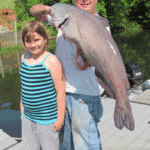
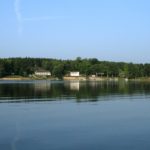
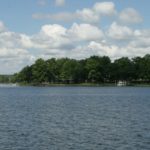
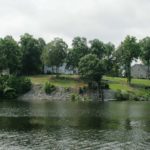
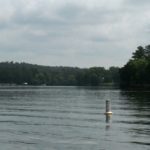
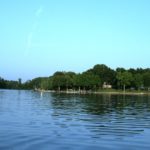
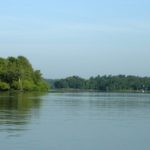
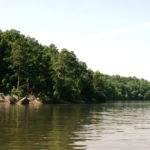
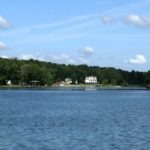
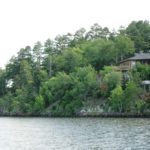
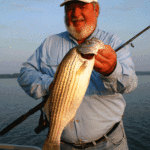
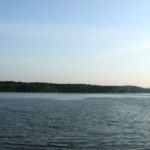
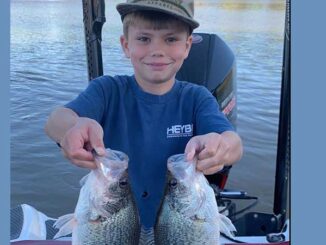
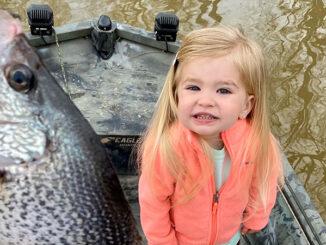
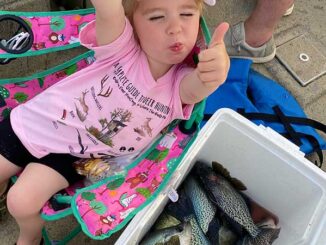

Be the first to comment